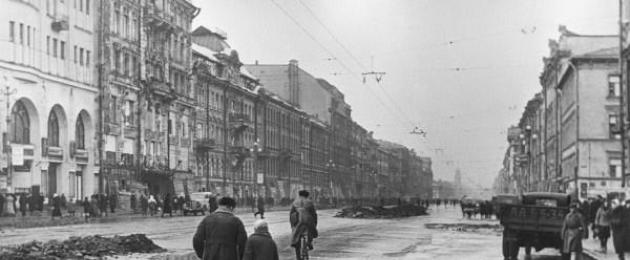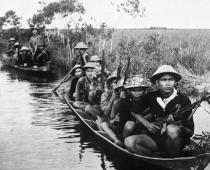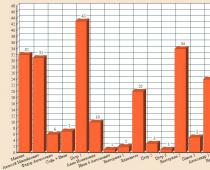January 27, the day of lifting the blockade of Leningrad, is special in the history of our country. Today, on this date, the Day of Military Glory is celebrated annually. The city of Leningrad (now St. Petersburg) itself received the title of Hero City on May 1, 1945. On May 8, 1965, the northern capital was awarded the "Gold Star" medal and the Medal for Leningrad was also received by 1.496 million inhabitants of this city.
"Leningrad under siege" - a project dedicated to the events of that time
The country has preserved the memory of these heroic events to this day. January 27 (the day the blockade of Leningrad was lifted) in 2014 is already the seventieth anniversary of the liberation of the city. The Archival Committee of St. Petersburg presented a project called "Leningrad under siege". On the Internet portal "Archives of St. Petersburg" a virtual exhibition of various archival documents relating to the history of this city during the blockade was created. About 300 historical originals of the time were published. These documents are grouped into ten different sections, each of which is accompanied by expert comments. All of them reflect various aspects of life in Leningrad during the blockade.
Reconstruction of the wartime situation

Today it is not easy for young Petersburgers to imagine that the magnificent city-museum in which they live was sentenced to complete destruction by the Germans in 1941. However, he did not capitulate when he was surrounded by Finnish and German divisions, and managed to win, although he was seemingly doomed to death. In order for the current generation of city residents to have an idea of what their great-grandfathers and grandfathers had to endure in those years (which the surviving residents of besieged Leningrad remember as the most terrible time), one of the modern streets of the city, Italian, as well as Manezhnaya the area was "returned" to the 70th anniversary in the winter of 1941-1944. This project was called "Street of Life".
In the aforementioned places in St. Petersburg, there are various cultural institutions, as well as theaters, which did not stop their activities even in those difficult blockade years. Here, the windows of the houses were sealed with crosses, as was done in Leningrad at that time in order to protect against air raids, barricades from sandbags on the pavements were reconstructed, anti-aircraft guns, military trucks were brought to complete the reproduction of the situation of that time. So the seventieth anniversary of the siege of Leningrad was marked. According to estimates, approximately 3,000 buildings were destroyed by shells during the events of those years, and more than 7,000 were significantly damaged. Residents of besieged Leningrad erected various defensive structures to protect themselves from shelling. They built about 4 thousand bunkers and pillboxes, equipped about 22 thousand different firing points in buildings, and also erected 35 kilometers of anti-tank obstacles and barricades on the streets of the city.

Siege of Leningrad: main events and figures
The defense of the city, which began on September 8, 1941, lasted about 900 days and ended in 1944. January 27 - All these years, the only way through which the necessary products were delivered to the besieged city, as well as the seriously wounded and children were taken out, was laid in winter on the ice of Lake Ladoga. It was the Road of Life of besieged Leningrad. We will talk about it in more detail in our article.
The blockade was broken on January 18, 1943, and Leningrad was completely cleared on January 27. And it happened only the next year - in 1944. Thus, the residents had to wait a long time before the blockade of the city of Leningrad was finally lifted. Died during this period, according to various sources, from 400 thousand to 1.5 million inhabitants. The following number figured at the Nuremberg trials - 632 thousand dead. Only 3% of them - from shelling and bombing. The rest of the inhabitants died of starvation.
Beginning of events
Today, military historians believe that not a single city on earth in the entire history of warfare gave as many lives for the Victory as Leningrad did at that time. On the day (1941, June 22), in this city, as well as throughout the region, martial law was immediately introduced. On the night of June 22-23, fascist German aviation tried to make a raid on Leningrad for the first time. This attempt ended unsuccessfully. None of the enemy aircraft was allowed to enter the city.
The next day, June 24, the Leningrad Military District was transformed into the Northern Front. Kronstadt covered the city from the sea. It was one of the bases located at that time in the Baltic Sea. With the advance of the enemy troops on the territory of the region, on July 10, a heroic defense began, which the history of Leningrad can be proud of. On September 6, the first Nazi bombs were dropped on the city, after which it began to be systematically attacked from the air. In just three months, from September to November 1941, 251 air raid alerts were issued.

Loudspeakers and famous metronome
However, the stronger the threat faced the hero city, the more united the inhabitants of Leningrad opposed the enemy. About 1,500 loudspeakers were installed on the streets to warn Leningraders about air raids that were taking place in the first months. The population was notified by radio network about the air raid alert. The famous metronome, which went down in history as a cultural monument of the time of resistance, was broadcast through this network. Its fast rhythm meant that a military alarm had been announced, and its slow rhythm meant a retreat. Mikhail Melaned, the announcer, announced the alarm. There was not a single area in the city to which an enemy projectile could not reach. Therefore, the streets and areas in which the risk of being hit was the greatest were calculated. Here, people hung out signs or wrote with paint that this place was the most dangerous during shelling.
According to the plan of Adolf Hitler, the city was to be completely destroyed, and the troops defending it were to be destroyed. The Germans, having failed in a number of attempts to break through the defenses of Leningrad, decided to starve him out.
The first shelling of the city

Every inhabitant, including the elderly and children, became the defender of Leningrad. A special army was created in which thousands of people rallied into partisan detachments and fought the enemy on the fronts, participated in the construction of defensive lines. The evacuation of the population from the city, as well as the cultural values of various museums and industrial equipment, began already in the first months of hostilities. On August 20, enemy troops occupied the city of Chudovo, blocking the railway in the Leningrad-Moscow direction.
However, the divisions of the army under the name "North" failed to break into Leningrad on the move, although the front came close to the city. Systematic shelling began on 4 September. Four days later, the enemy captured the city of Shlisselburg, as a result of which land communication with the mainland of Leningrad was stopped.
This event was the beginning of the blockade of the city. It turned out to be over 2.5 million inhabitants, including 400 thousand children. By the beginning of the blockade, the city did not have the necessary food supplies. As of September 12, they were calculated for only 30-35 days (bread), 45 days (cereals) and 60 days (meat). Even with the strictest economy, coal could last only until November, and liquid fuel - only until the end of the current one. Food rations, which were introduced under the rationing system, began to gradually decline.
Hunger and cold
The situation was aggravated by the fact that the winter of 1941 was early in Russia, and in Leningrad it was very fierce. Often the thermometer dropped to -32 degrees. Thousands of people died of hunger and cold. The peak of mortality was the time from November 20 to December 25 of this difficult 1941. During this period, the norms for issuing bread to fighters were significantly reduced - up to 500 grams per day. For those who worked in the hot shops, they amounted to only 375 grams, and for the rest of the workers and engineers - 250. For other segments of the population (children, dependents and employees) - only 125 grams. There were practically no other products. More than 4,000 people died of starvation every day. This figure was 100 times higher than the pre-war mortality rate. At the same time, male mortality significantly prevailed over female. By the end of the war, representatives of the weaker sex made up the bulk of the inhabitants of Leningrad.
The Role of the Road of Life in Victory

Communication with the country was carried out, as already mentioned, by the Road of Life of besieged Leningrad, passing through Ladoga. It was the only highway that was available between September 1941 and March 1943. It was along this road that the evacuation of industrial equipment and the population from Leningrad took place, the supply of food to the city, as well as weapons, ammunition, reinforcements and fuel. In total, over 1,615,000 tons of cargo was delivered to Leningrad along this route, and about 1.37 million people were evacuated. At the same time, in the first winter, about 360 thousand tons of cargo were received, and 539.4 thousand residents were evacuated. A pipeline was laid along the bottom of the lake in order to supply oil products.
Protecting the Road of Life
Constantly bombed and shelled the Road of Life by the Nazi troops in order to paralyze this only saving way. To protect it from air strikes, as well as to ensure uninterrupted operation, the means and forces of the country's air defense were involved. In various memorial ensembles and monuments today, the heroism of the people who made it possible for uninterrupted movement along it is immortalized. The main place among them is occupied by the "Broken Ring" - a composition on Lake Ladoga, as well as an ensemble called "Rumbolovskaya Mountain", located in Vsevolzhsk; in the village of Kovalevo), which is dedicated to the children who lived in Leningrad in those years, as well as a memorial complex installed in the village called Chernaya Rechka, where the soldiers who died on the Ladoga road rested in a mass grave.
Lifting the blockade of Leningrad
The blockade of Leningrad was broken for the first time, as we have already said, in 1943, on January 18th. This was carried out by the forces of the Volkhov and Leningrad fronts together with the Baltic Fleet. The Germans were pushed back. Operation "Iskra" took place during the general offensive of the Soviet Army, which was widely deployed in the winter of 1942-1943 after the enemy troops were surrounded near Stalingrad. Army "North" acted against the Soviet troops. On January 12, the troops of the Volkhov and Leningrad fronts went on the offensive, and six days later they united. On January 18, the city of Shlisselburg was liberated, and the southern coast of the strategically important Lake Ladoga was also cleared of the enemy. A corridor was formed between it and the front line, the width of which was 8-11 km. Through it for 17 days (just think about this period!) Automobile and railway routes were laid. After that, the supply of the city improved dramatically. The blockade was completely lifted on 27 January. The day of lifting the siege of Leningrad was marked by fireworks that lit up the sky of this city.
The siege of Leningrad was the most brutal in the history of mankind. Most of the residents who died at that time are buried today at the Piskarevsky Memorial Cemetery. The defense lasted, to be precise, 872 days. Leningrad of the pre-war time after that was no more. The city has changed a lot, many buildings had to be restored, some were rebuilt.
Diary of Tanya Savicheva

From the terrible events of those years, there are many testimonies. One of them is Tanya's diary. Leningradka began to conduct it at the age of 12. It was not published, since it consists of only nine terrible records about how members of the family of this girl died in succession in Leningrad at that time. Tanya herself also failed to survive. This notebook was presented at the Nuremberg trials as an argument accusing fascism.
This document is located today in the museum of the history of the hero city, and a copy is kept in the showcase of the memorial of the aforementioned Piskarevsky cemetery, where 570 thousand Leningraders were buried during the blockade of those who died of starvation or bombing in the period from 1941 to 1943, as well as in Moscow on Poklonnaya Hill .
The hand, which was losing strength due to hunger, wrote sparingly, unevenly. Struck by suffering, the child's soul was no longer capable of living emotions. The girl only recorded the terrible events of her life - "death visits" to her family's house. Tanya wrote that all the Savichevs were dead. However, she never found out that not everyone died, their race continued. Sister Nina was rescued and taken out of the city. She returned in 1945 to Leningrad, to her native home, and found Tanya's notebook among the plaster, fragments and bare walls. Brother Misha also recovered from a severe wound received at the front. The girl herself was discovered by employees of the sanitary teams who went around the houses of the city. She fainted from hunger. She, barely alive, was evacuated to the village of Shatki. Here, many orphans got stronger, but Tanya never recovered. For two years, doctors fought for her life, but the girl still died. She died in 1944, July 1st.
- In contact with 0
- Google Plus 0
- OK 0
- Facebook 0








